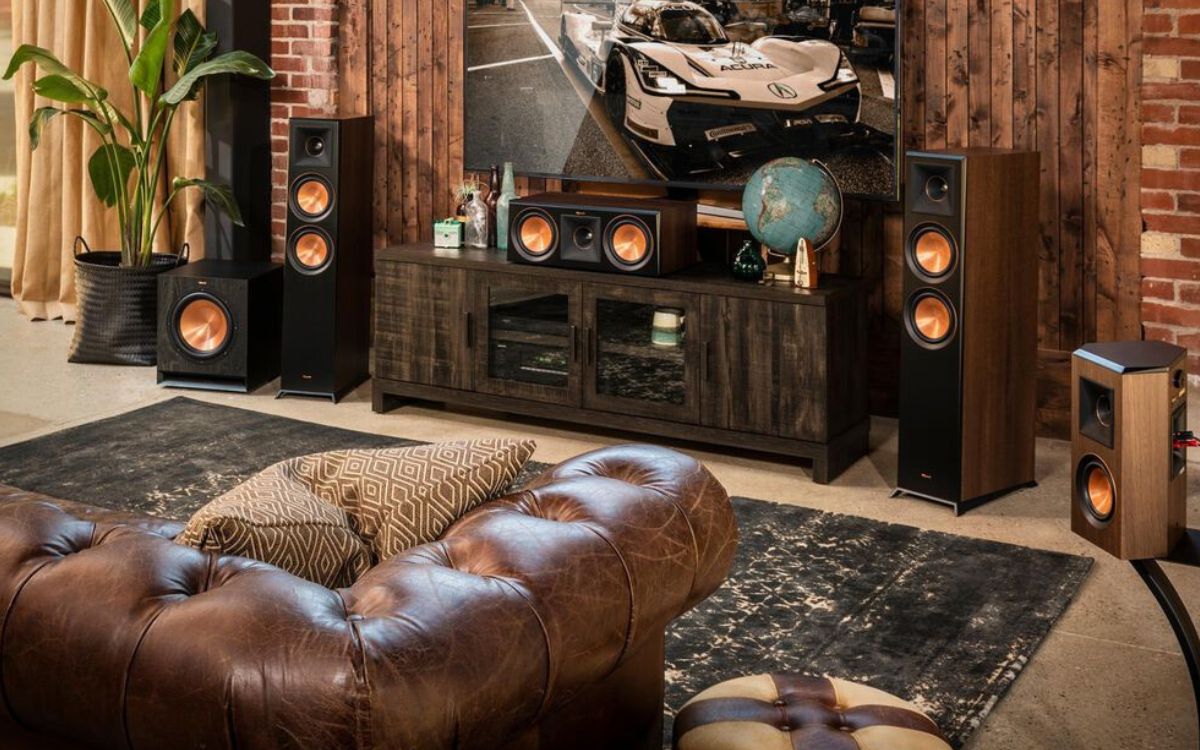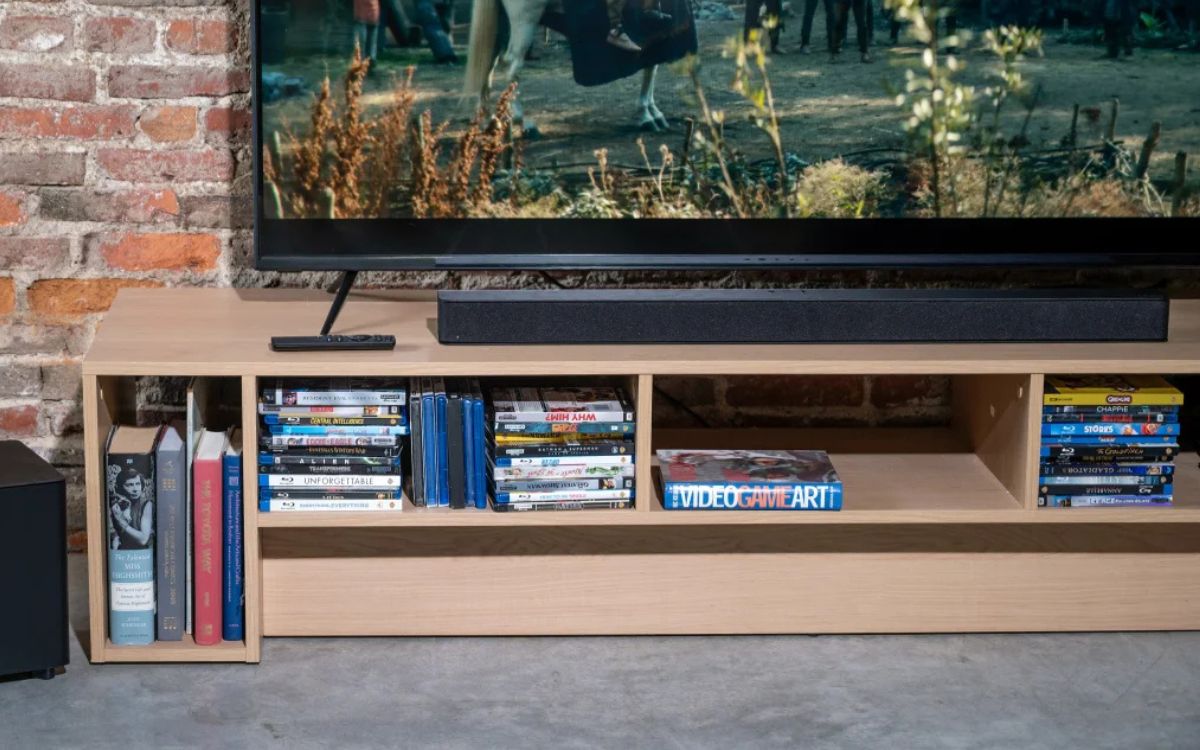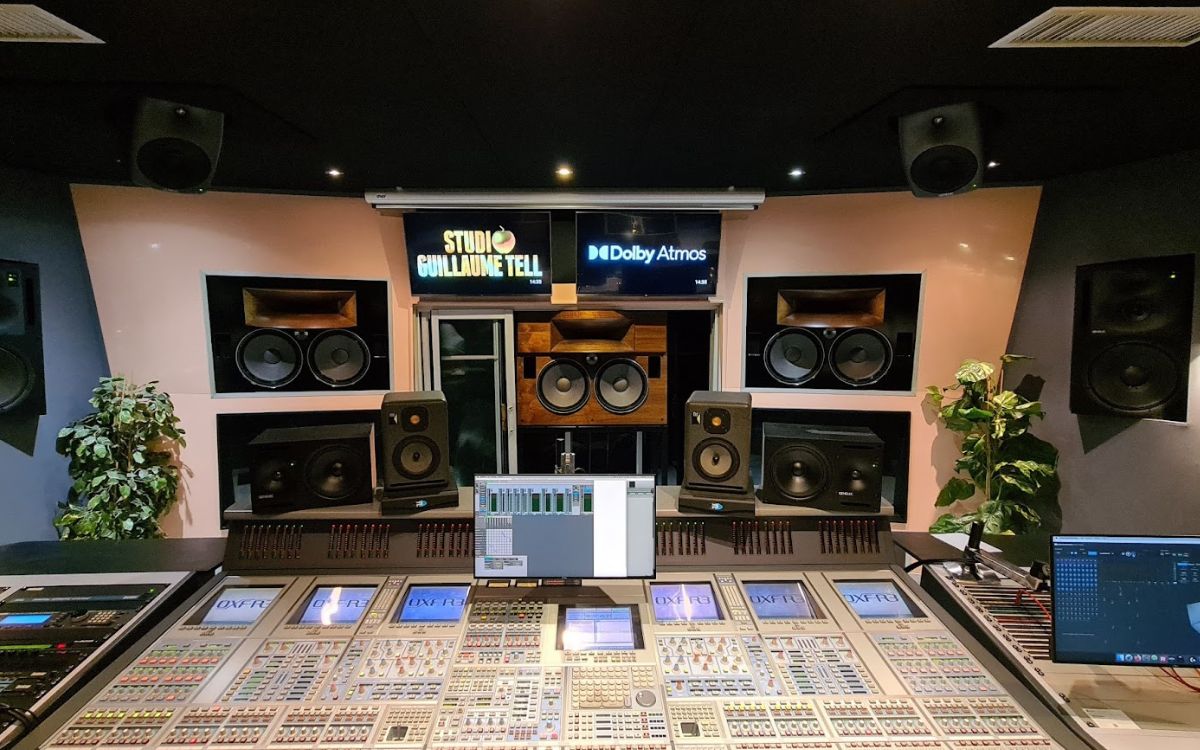Home>Production & Technology>Surround Sound>What Do You Need For Surround Sound


Surround Sound
What Do You Need For Surround Sound
Modified: February 17, 2024
Get the ultimate surround sound experience with our top-notch audio equipment. Discover what you need to create a captivating sound environment.
(Many of the links in this article redirect to a specific reviewed product. Your purchase of these products through affiliate links helps to generate commission for AudioLover.com, at no extra cost. Learn more)
Table of Contents
Introduction
Welcome to the immersive world of surround sound! Whether you’re a casual movie lover, a music enthusiast, or a dedicated gamer, surround sound can take your audio experience to a whole new level. With its ability to create a realistic and captivating soundstage, surround sound brings depth, richness, and spatial awareness to your entertainment setup.
In this article, we will delve into the world of surround sound and explain the essential components you need to create an impressive audio system. From understanding the basics to optimizing speaker placement, we will break down the key elements that make up a surround sound setup.
Surround sound technology allows for the distribution of audio across multiple channels, creating a three-dimensional sound environment that envelops the listener. By strategically placing speakers around the room, surround sound systems can reproduce audio with directional cues and a sense of depth, making you feel like you’re right in the middle of the action.
Whether you’re watching a movie and hearing the sound of a car zooming past you, or playing a video game and feeling immersed in the virtual world, surround sound enhances your overall sensory experience. It adds another layer of realism and excitement to your audio, making it an essential component for any home theater or entertainment space.
Now that you understand the concept and benefits of surround sound, let’s dive deeper into the various components that make up a surround sound system. From the audio source to the speaker placement, each element plays a crucial role in delivering an outstanding audio experience.
Understanding Surround Sound
Before we dive into the components of a surround sound system, let’s take a moment to understand the underlying principles of surround sound technology.
Surround sound systems are designed to replicate the experience of being in a live performance or a movie theater by delivering an immersive audio experience. The aim is to create a soundstage that surrounds the listener, providing a sense of direction and depth to the sound.
Surround sound is typically achieved through the use of multiple audio channels. The most common surround sound formats include 5.1, 7.1, and even 9.1 systems. The first number specifies the number of main speakers, while the second number indicates the number of subwoofers. For example, a 5.1 system consists of five main speakers and one subwoofer.
The main channels of a surround sound system include the front left, front right, center, surround left, and surround right speakers. The center speaker is responsible for dialogue and vocals, while the front and surround speakers create a sense of space and ambiance. The subwoofer is dedicated to reproducing low-frequency sounds, adding depth and impact to the audio.
In addition, some advanced surround sound systems incorporate additional speakers, such as overhead speakers or height speakers, to create a more immersive and three-dimensional sound experience. These systems, known as Dolby Atmos or DTS:X, can add a vertical dimension to the sound, allowing for precise audio placement and movement.
To harness the full potential of surround sound, it is important to ensure proper speaker placement. The speakers should be strategically positioned to create an optimal soundstage and deliver the intended audio effects. Additionally, calibration tools are often used to fine-tune the system, ensuring that each speaker is outputting the correct level of sound and is in sync with the others.
Now that we have a foundational understanding of surround sound technology, let’s explore the essential components that make up a surround sound system and how they all work together to create an immersive audio experience.
Components of Surround Sound
A surround sound system is composed of several key components that work together to deliver an immersive audio experience. Let’s take a closer look at each component:
- Audio Source: The audio source is where the sound originates. It can be a Blu-ray player, a game console, a streaming device, or any other device that outputs audio. High-quality audio sources, such as lossless audio formats or Blu-ray discs, can provide the best audio fidelity.
- AV Receiver: The AV receiver is the central hub of the surround sound system. It receives the audio signals from the source and distributes them to the speakers. The AV receiver decodes the surround sound formats and amplifies the audio signals to provide the necessary power for the speakers.
- Speakers: The speakers are an integral part of a surround sound system. There are several types of speakers, including front speakers, surround speakers, and a center speaker. The front speakers primarily handle music and sound effects, while the center speaker reproduces dialogue and vocals. Surround speakers create a sense of atmosphere and space, immersing the listener in the audio environment.
- Subwoofer: The subwoofer is responsible for reproducing low-frequency sounds, adding depth and impact to the audio. It delivers the rumbling bass in explosions, the deep notes in music, and the low-end effects that enhance the overall cinematic experience.
- Speaker Placement: Proper speaker placement is crucial for achieving optimal surround sound. The front speakers should be positioned on either side of the screen or listening area, while the center speaker should be placed above or below the screen to ensure clear dialogue reproduction. Surround speakers should be positioned to the side or behind the listener, creating an enveloping soundstage. The subwoofer can be placed anywhere in the room, as its low-frequency sounds are non-directional.
- Speaker Cables: Speaker cables connect the speakers to the AV receiver. It is important to use high-quality cables with appropriate gauge and length to minimize signal loss and maintain audio fidelity.
- Calibration Tools: Calibration tools, such as an audio calibration microphone and room correction software, help optimize the surround sound system. They analyze the room’s acoustics and adjust the audio settings to deliver the best possible sound quality in your specific environment.
By understanding and investing in these essential components, you can create a surround sound system that brings your audio to life. From the audio source to the calibration tools, each component is crucial for achieving an immersive and captivating audio experience.
Audio Source
The audio source is where the sound originates in a surround sound system. It can be any device that outputs audio, such as a Blu-ray player, a game console, a streaming device, or even a turntable. The quality of the audio source has a significant impact on the overall sound fidelity of your surround sound system.
When choosing an audio source, it is important to consider the format and quality of the audio it can produce. Blu-ray players or media streamers that support lossless audio formats, such as Dolby TrueHD or DTS-HD Master Audio, are ideal choices for high-resolution audio. These formats provide uncompressed audio tracks that retain the full dynamic range and detail of the original recording.
If you primarily use your surround sound system for gaming, ensure that your game console supports surround sound output. Many modern gaming consoles, such as PlayStation and Xbox, support surround sound formats like Dolby Atmos or DTS:X, which can enhance your gaming experience with immersive audio effects.
Streaming devices, like Apple TV or Roku, offer convenient access to online streaming services. It is worth noting that the audio quality from streaming services can vary depending on the service and your internet connection. Some streaming services, like Netflix or Amazon Prime Video, offer audio formats like Dolby Atmos, providing an enhanced audio experience if your system supports it.
If you’re a vinyl enthusiast, you can integrate a turntable into your surround sound system. You will need a phono preamplifier to amplify the turntable’s audio signal to line level and connect it to your AV receiver’s analog audio inputs. This allows you to enjoy the warm and rich sound of vinyl records in your surround sound setup.
Regardless of the audio source you choose, ensure that it supports the necessary audio formats and outputs the signal to your AV receiver through an appropriate connection, such as HDMI or optical. This allows for seamless integration with your surround sound system and ensures compatibility with the other components.
Remember, the audio source serves as the foundation of your audio experience. Investing in high-quality audio sources will maximize the potential of your surround sound system and deliver immersive and lifelike sound reproduction.
AV Receiver
The AV receiver is the heart of your surround sound system. It acts as the central hub that connects and controls all the audio and video components. The AV receiver receives audio signals from your audio source and distributes them to the appropriate speakers, amplifying the signals to produce the desired sound levels. Additionally, it handles video signals, allowing you to switch between different video sources and connect them to your display device.
One of the key features to consider when choosing an AV receiver is the number of audio channels it supports. The most common configurations are 5.1, 7.1, or even higher, such as 9.1 or 11.1 systems. The number represents the total number of speakers and subwoofers that the receiver can handle. For example, a 5.1 receiver can support five main speakers and one subwoofer, while a 7.1 receiver can accommodate seven main speakers and one or two subwoofers.
Another important feature to consider is the audio decoding capabilities of the AV receiver. It should support popular surround sound formats like Dolby Digital, DTS, Dolby TrueHD, and DTS-HD Master Audio. These formats allow you to enjoy high-quality audio with immersive surround sound effects.
Connectivity options are also crucial when choosing an AV receiver. Look for receivers that offer multiple HDMI inputs and outputs for seamless integration with various audio and video sources, such as Blu-ray players, gaming consoles, and media streamers. Other important connections include optical and coaxial digital inputs, analog audio inputs, and USB ports for connecting external devices.
Some AV receivers come with built-in networking capabilities, allowing you to stream audio wirelessly from your mobile devices, access internet radio stations, or even control the receiver through dedicated mobile apps. This adds convenience and flexibility to your audio setup.
Furthermore, room calibration features are an excellent addition to AV receivers. These features, such as Audyssey or Yamaha’s YPAO, analyze the acoustics of your room and automatically adjust the speaker settings to optimize the audio performance. They can compensate for room anomalies and ensure accurate sound reproduction in any environment.
When selecting an AV receiver, consider your future needs as well. Ensure that the receiver has enough power to drive your speakers and accommodate any future upgrades or additional speakers you may want to add. Additionally, keep an eye out for firmware updates and potential compatibility with emerging audio and video technologies.
An AV receiver acts as the core component that ties your entire surround sound system together. Choosing a high-quality receiver with the right features and connectivity options will ensure optimal audio performance and a seamless integration of your audio and video sources.
Speakers
Speakers are essential components of any surround sound system. They are responsible for reproducing the audio and creating an immersive soundstage that surrounds the listener. In a typical surround sound setup, there are several types of speakers that play different roles in delivering a well-balanced and accurate audio experience.
Front Speakers: The front speakers, also known as the main speakers, play a crucial role in delivering music, dialogue, and sound effects. Typically, they consist of a left and right speaker. These speakers handle most of the audio content and provide the foundation for the overall soundstage. They should be positioned at equal distances from the viewing or listening area and ideally at ear level for the best performance.
Center Speaker: The center speaker is responsible for reproducing dialogue and vocals. It plays a vital role in ensuring clear and intelligible speech. The center speaker should be positioned either above or below the screen, aligned with the front left and right speakers. This arrangement ensures that dialogue appears to come from the center of the screen, enhancing the realism of on-screen conversations.
Surround Speakers: Surround speakers are designed to create a sense of space and ambiance. They are placed to the side or behind the listening area to envelop the viewer with sound. In a 5.1 setup, there are two surround speakers (left surround and right surround). In larger setups like 7.1 or 9.1, additional surround speakers are added for a more immersive experience. These speakers help create a multi-dimensional audio environment, enhancing the sense of movement and realism in movies and games.
Height or Overhead Speakers: Some advanced surround sound systems incorporate height or overhead speakers to add a vertical dimension to the audio experience. These speakers, also known as Dolby Atmos enabled speakers, are placed above the listener or installed in the ceiling. They create a more immersive three-dimensional sound environment, allowing for precise audio placement and movement. Height speakers are particularly effective when paired with content encoded in Dolby Atmos or DTS:X formats.
When selecting speakers, consider their frequency response, sensitivity, and power handling capabilities. A balanced frequency response ensures accurate sound reproduction across various frequencies, while high sensitivity ensures efficient energy conversion, resulting in louder sound with less power. It is also important to match the power handling of the speakers to the power output of your AV receiver to prevent damaging the speakers.
Lastly, pay attention to the quality and construction of the speakers. High-quality speaker drivers, cabinets, and crossovers contribute to accurate and detailed sound reproduction. Consider factors such as driver materials, cabinet design, and speaker construction techniques when choosing speakers for your surround sound system.
Investing in high-quality speakers will greatly enhance your surround sound experience, providing a detailed, immersive, and well-balanced audio performance that brings your movies, music, and games to life.
Subwoofer
The subwoofer is a crucial component of a surround sound system that specializes in reproducing low-frequency sounds. It adds depth, impact, and power to the audio, creating a more immersive and engaging experience. The subwoofer is responsible for handling the lower end of the frequency spectrum, typically from 20 Hz to 200 Hz.
Low-frequency sounds, such as explosions, rumbling thunder, or deep bass in music, can be felt as much as they are heard. The subwoofer is designed to reproduce these deep bass frequencies with superior accuracy and power. It enhances the realism of explosions, intensifies the impact of movie soundtracks, and adds weight to bass-heavy music genres like electronic or hip-hop.
When choosing a subwoofer, several factors should be considered. These include the size of your room, your speaker setup, and your personal preferences. A larger subwoofer with a bigger driver and amplifier can deliver more impactful bass, while a smaller subwoofer may be more suitable for a compact room or for complementing smaller satellite speakers.
Placement of the subwoofer is important to achieve optimal bass reproduction. Ideally, the subwoofer should be positioned near the front speakers, as low frequencies are non-directional and can be difficult to localize. Experiment with different locations within your room to find the position that provides the most even bass response and integration with your other speakers.
Some subwoofers come with built-in controls or a separate subwoofer amplifier, allowing you to adjust the bass level, phase, and crossover frequency. These controls help fine-tune the subwoofer’s performance and ensure it seamlessly blends with the rest of your speakers.
It’s also worth noting that some AV receivers come with built-in subwoofer calibration features, such as Audyssey or YPAO. These systems can analyze the acoustics of your room and automatically adjust the subwoofer settings to optimize the low-frequency performance.
When it comes to connecting the subwoofer to your surround sound system, most AV receivers have a dedicated subwoofer output. This output carries the low-frequency information to the subwoofer via a mono RCA or a dedicated subwoofer cable. Ensure that your AV receiver has this output and that the subwoofer you choose has the appropriate input for it.
The addition of a subwoofer to your surround sound system will greatly enhance its audio performance by providing the deep, impactful bass that completes the overall listening experience. Whether you enjoy explosive action movies or pulse-pounding music, the subwoofer adds an extra layer of immersion and excitement to your audio setup.
Speaker Placement
The proper placement of speakers is crucial for achieving optimal surround sound performance. Each speaker has a specific role in creating a realistic and immersive audio experience. By strategically placing the speakers in your room, you can ensure accurate sound localization, a balanced soundstage, and an enhanced sense of immersion.
Front Speakers: The front speakers, consisting of the left and right speakers, should be positioned at equal distances from the main listening area. These speakers should ideally be placed at ear level to ensure the sound reaches your ears directly. If your speakers are floor-standing, place them on stable stands or directly on the floor. If they are bookshelf speakers, use appropriate speaker stands or shelves to achieve the correct height.
Center Speaker: The center speaker, responsible for dialogue and vocals, plays a critical role in a surround sound system. It should be placed either above or below the display screen, aligned with the left and right front speakers. This arrangement ensures that dialogue appears to come from the center of the screen, enhancing the clarity and realism of on-screen conversations.
Surround Speakers: The surround speakers are positioned to the side or behind the listening area, creating a sense of spaciousness and envelopment. For a 5.1 system, place the surround speakers slightly behind the listening area, angled towards the seating position. This setup creates an immersive effect by simulating sounds coming from the sides or behind. In larger setups like 7.1 or 9.1 systems, additional surround speakers can be placed at more precise angles to achieve a more accurate soundfield.
Height or Overhead Speakers: If you have height or overhead speakers for an advanced surround sound format like Dolby Atmos, their positioning is critical. These speakers should be installed either in the ceiling or mounted high above ear level. Dolby Atmos-enabled speaker modules can be placed on top of the front or surround speakers for a more accessible installation. Ensure that the height speakers are angled towards the listening area to provide an immersive and three-dimensional audio experience.
When placing the speakers, keep in mind the room’s layout and acoustics. Large pieces of furniture, walls, or other obstacles can affect the sound propagation. Experiment with different speaker positions and angles to find the placement that provides the best sound balance and imaging in your specific room.
It’s also important to consider the seating position within the room. Ideally, the listening position should be at an equal distance from the front speakers and at an optimal distance from the surround speakers. This helps ensure that you experience the full immersive impact of the surround sound system without any significant audio imbalances.
Lastly, consider using speaker mounts, brackets, or stands to achieve the desired speaker placement. These accessories allow for easy adjustment and secure positioning. Ensure that the speakers are firmly secured and that any adjustable components are tightened appropriately to avoid any accidents or unwanted movement.
Proper speaker placement is essential for creating a realistic and immersive surround sound experience. Take the time to experiment with speaker positions, angles, and distances to achieve optimal sound reproduction and enjoy the full potential of your surround sound system.
Speaker Cables
While often overlooked, the quality and proper installation of speaker cables play a significant role in ensuring optimal audio performance in a surround sound system. Speaker cables are responsible for transmitting the audio signal from the AV receiver to each speaker, and they should be carefully selected to maintain signal integrity and deliver accurate sound reproduction.
When choosing speaker cables, consider the following factors:
Gauge: The gauge of the speaker cable refers to its thickness, with lower gauge numbers indicating a thicker cable. Thicker cables generally offer lower resistance, minimizing signal loss and ensuring efficient power delivery to the speakers. As a general guideline, for shorter cable runs, a 16 or 14-gauge cable should suffice, while longer runs may benefit from a thicker 12 or 10-gauge cable.
Length: It is important to measure the distance between your AV receiver and each speaker to determine the required length of your speaker cables. Allow for some extra length to accommodate any necessary routing or adjustments. Avoid excessively long cables, as they can introduce signal degradation. It is advisable to keep the speaker cables as short as possible without sacrificing functionality or convenience.
Material: Speaker cables are typically made of copper, as it has excellent conductivity properties. Copper-plated or oxygen-free copper (OFC) cables are commonly used for their superior signal transmission capabilities. Some premium speaker cables may utilize other conductive materials or incorporate special insulation or shielding to reduce interference and maintain signal purity.
Connectors: Speaker cables often feature connectors at their ends to facilitate easy and secure connections. Banana plugs, spade connectors, or bare wire ends are common options. Select the type of connector that is compatible with your speakers and AV receiver and provides a reliable connection.
When running speaker cables, ensure that they are safely routed and well-insulated to prevent signal loss or interference. Keep them away from potential sources of electromagnetic interference (such as power cables or electronics) to avoid any humming or buzzing noises. Keep the cables organized and neat, either by using cable management solutions or concealing them behind furniture or wall channels.
It is advisable to purchase speaker cables from reputable brands or manufacturers that provide quality assurance. Consider the overall build quality, durability, and customer reviews when making your selection.
When connecting the speaker cables, ensure that they are properly matched to the corresponding terminals on both the AV receiver and the speakers. Follow the instructions provided by the manufacturer to ensure a secure and correct connection, while avoiding any accidental short circuits.
Investing in high-quality speaker cables and installing them properly ensures optimal signal transmission, reduces the risk of audio distortion, and helps maintain the overall integrity of your surround sound system. By paying attention to this often overlooked aspect of your setup, you can fully enjoy the immersive and high-fidelity audio experience that surround sound systems have to offer.
Calibration Tools
Calibration tools are invaluable for optimizing the performance of your surround sound system. They help fine-tune the audio settings, correcting any audio imbalances or room-specific issues that may affect the overall sound quality. Calibration tools analyze the acoustics of your room and adjust the speaker settings to ensure accurate sound reproduction.
There are several types of calibration tools available in the market, each offering unique features and capabilities. Here are some common calibration tools used in surround sound systems:
Audio Calibration Microphone: An audio calibration microphone is a crucial component in the calibration process. It is a specialized microphone designed to pick up and measure the audio signals emitted by the speakers. The microphone captures the sound output from each speaker and sends the data to the calibration software or built-in calibration system in your AV receiver.
Room Correction Software: Many AV receivers come with built-in room correction software. This software utilizes the data from the audio calibration microphone to analyze the acoustic characteristics of your listening room. It then applies specific corrections to the audio settings, such as equalization and time alignment, to optimize the audio performance. Room correction software can compensate for room resonances, reflections, and other acoustic anomalies, resulting in more accurate and balanced sound reproduction.
Multi-Channel Sound Calibrator: A multi-channel sound calibrator is a tool used to measure the sound level output from each speaker in your surround sound system. It ensures that each speaker is producing the same audio level, preventing discrepancies in sound perception and ensuring a consistent and seamless audio experience.
Test Tone Generators: Test tone generators are handy tools for speaker calibration. They produce specific audio frequencies, allowing you to verify that each speaker in your system is reproducing the sound correctly. Test tone generators help identify any channel imbalances, speaker placement issues, or faulty connections that may affect the overall audio performance.
Calibrating your surround sound system with these tools is a straightforward process. In most cases, you will follow the step-by-step instructions provided by your AV receiver’s user manual or the specific calibration tool manufacturer. The calibration process typically involves placing the audio calibration microphone in the listening position, running the calibration software or built-in calibration system, and following prompts to measure and adjust the speaker settings accordingly.
It is recommended to perform calibration periodically, especially if you make changes to your room layout or speaker setup. This ensures that your surround sound system continues to provide optimal audio performance based on your specific acoustic environment.
By utilizing calibration tools, you can achieve precise audio reproduction, balanced sound, and an immersive listening experience tailored to your room’s unique characteristics. Calibration enhances the performance of your surround sound system, allowing you to fully immerse yourself in your favorite movies, music, and games.
Conclusion
Creating a surround sound system allows you to transform your home theater or entertainment space into an immersive audio environment. By understanding the essential components and optimizing their placement, you can achieve a captivating and lifelike audio experience.
The audio source serves as the foundation of your surround sound system, so choose high-quality sources that support the desired audio formats. An AV receiver acts as the central hub, decoding and distributing audio signals to the speakers. Choose a receiver with the right number of channels and connectivity options to suit your setup.
Speakers play a crucial role in delivering precise and immersive sound. Front speakers handle music, dialogue, and sound effects, while the center speaker reproduces clear vocals. Surround speakers create a sense of space and ambiance, and height speakers add an extra dimension in advanced setups. The subwoofer brings depth and impact to low-frequency sounds, enhancing the overall audio experience.
Proper speaker placement is essential to achieve optimal sound reproduction. Ensure that the speakers are positioned correctly, taking into account factors such as distance, height, and angle. Speaker cables should be of the appropriate gauge and length to minimize signal loss and maintain audio fidelity.
Calibration tools, such as an audio calibration microphone and room correction software, help optimize your surround sound system. Use these tools to analyze your room’s acoustics and fine-tune the audio settings, ensuring accurate sound reproduction and a balanced soundstage.
In conclusion, building a surround sound system requires careful consideration of the components and their placement. By investing in high-quality equipment, utilizing calibration tools, and paying attention to speaker positioning, you can create an immersive audio experience that brings movies, music, and games to life. So, gather your favorite content, sit back, and enjoy the immersive and captivating audio journey that a well-designed surround sound system provides.











